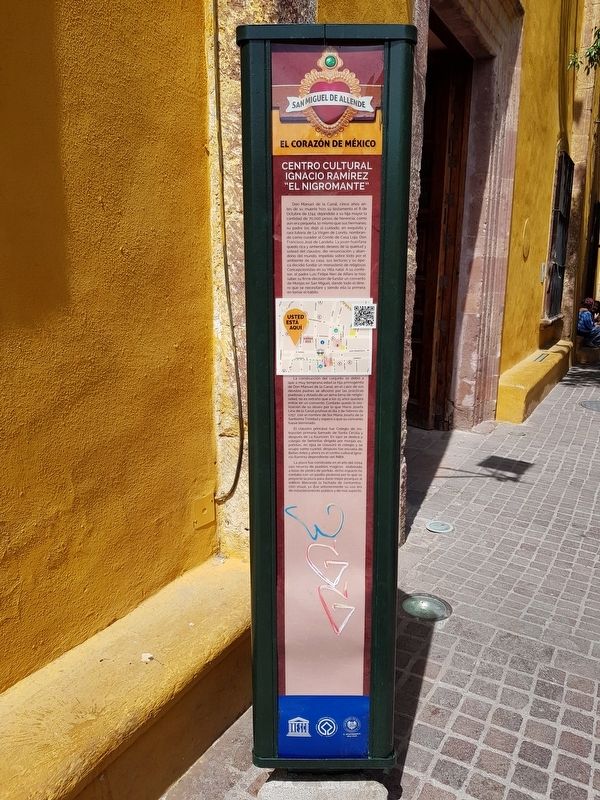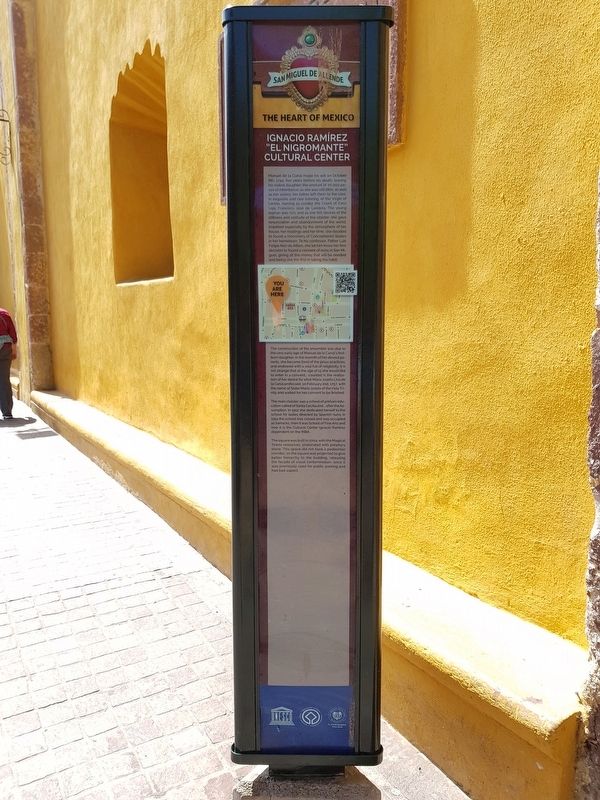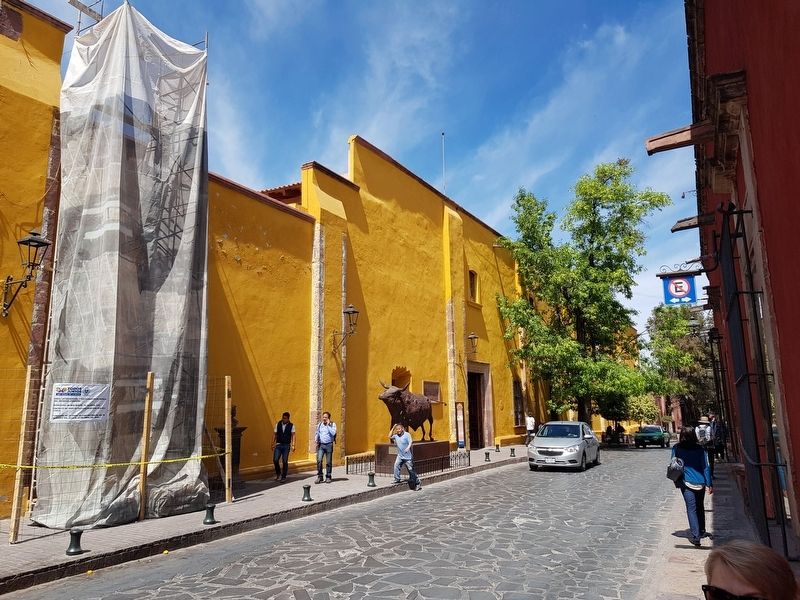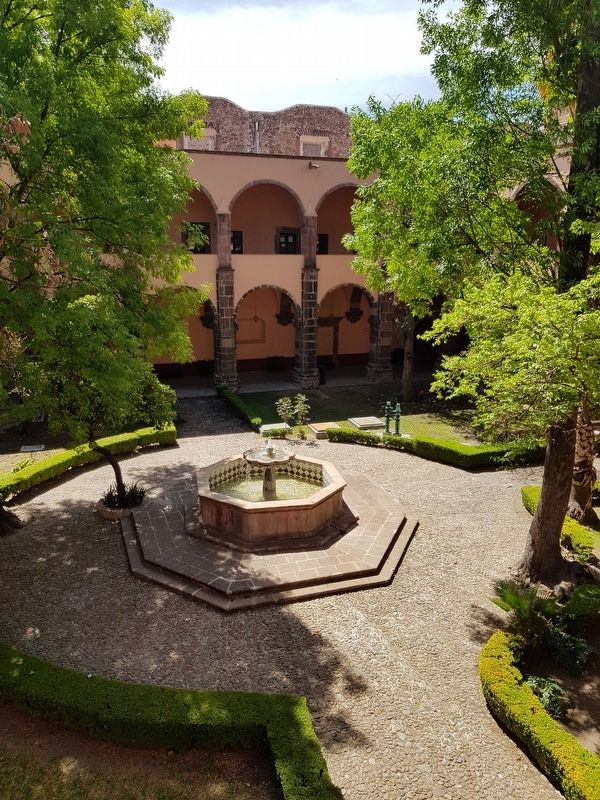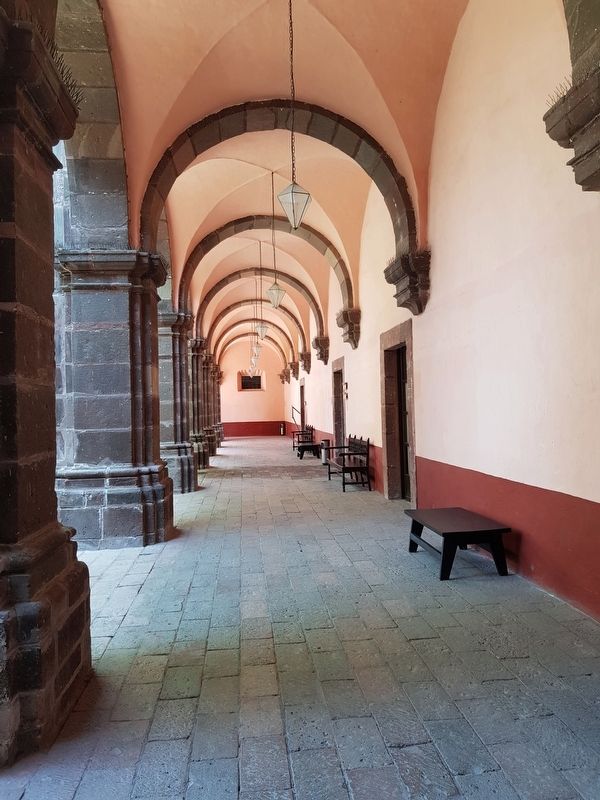San Miguel de Allende, Guanajuato, Mexico — The Central Highlands (North America)
Ignacio Ramírez “El Nigromante” Cultural Center
San Miguel de Allende - El Corazón de México
Inscription.
Don Manuel de la Canal, cinco años antes de su muerte hizo su testamento el 8 de Octubre de 1744, dejándole a su hija mayor la cantidad de 70,000 pesos de herencia; como aún era pequeña, lo mismo que sus hermanas, su padre los dejó al cuidado, en exquisita y rara tutoria de La Virgen de Loreto, nombrando como curador al Conde de Casa Loja, Don Francisco José de Landeta. La joven huérfana quedó rica y sintiendo deseos de la quietud y solead del claustro, dio reunciación y abandono del mundo, impelida sobre todo por el ambiente de su casa, sus lecturas y su época decidió fundar un monasterior de religiosas Concepcionistas en su Villa natal. A su confesor, el padre Luis Felipe Neri de Alfaro le hizo saber su firme decisión de fundar un convento de Monjas en San Miguel, dando todo el dinero que se necesitare y siendo ella la primera en tomar el hábito.
La construcción del conjunto se debió a que a muy temprana edad la hija primogénita de Don Manuel de la Canal, en el calor de sus devotos padres se aficionó por las prácticas piadosas y dotadas de un alma llena de religiosidad, no es extraño que a los 15 años quisiera entrar en un convento. Contada queda la realización de su deseo por lo que María Josefa Lina de Canal profesó el día 2 de febrero de 1757, con el nombre de Sor María Josefa de la Santísima Trinidad y esperó a que su convento fuese terminado.
El claustro principal fue Colegio de instrucción primaria llamado de Santa Cecilia y después de La Asunción. En 1912 se dedicó a colegio de Señoritas dirigido por monjas españolas; en 1914 se clausuró el colegio y se ocupó como cuartel, después fue escuela de Bellas Artes y ahora es el centro cultural Ignacio Ramírez dependiente del INBA.
La plaza fue construida en el año de 2004 con recurso de pueblos mágicos elaborada a base de piedra de pórfido, dicho espacio no contaba con un pasillo peatonal por lo que se proyecto la plaza para darle mejor jerarquía al edificio liberando la fachada de contaminación visual, ya que anteriormente su uso era de estacionamiento público y de ma aspecto.
Ignacio Ramírez “El Nigromante” Cultural Center
Manuel de la Canal made his will on October 8th, 1744, five years before his death, leaving his eldest daughter the amount of 70,000 pesos of inheritance, as she was still little, as well as her sisters, her father left them to the care, in exquisite and rare tutoring, of the
Virgin of Loreto, naming as curator the Count of Casa Loja, Francisco José de Landeta. The young orphan was rich, and as she felt desires of the stillness and solitude of the cloister, she gave renunciation and abandonment of the world. Impelled especially by the atmosphere of her house, her readings and her time, she decided to found a monastery of Conceptionist Sisters in her hometown. To his confessor, Father Luis Felipe Neri de Alfaro, she let him know her firm decision to found a convent of nuns in San Miguel, giving all the money that will be needed and being she the first in taking the habit.
The construction of the ensemble was due to the very early age of Manuel de la Canal’s firstborn daughter. In the warmth of her devout parents, she became fond of the pious practices, and endowed with a soul full of religiosity, it is not strange that at the age of 15 she would like to enter in a convent…counted is the realization of her desire for what María Josefa Lina de la Canal professed on February 2nd, 1757, with the name of Sister María Josefa of the Holy Trinity and waited for her convent to be finished.
The main cloister was a school of primary education called of Santa Cecilia and…after the Assumption. In 1912 she dedicated herself to the school for ladies directed by Spanish nuns; in 1914 the school was closed and was occupied as barracks, then it was School
of Fine Arts and now it is the cultural Center Ignacio Ramírez dependent on the INBA.
The square was built in 2004, with the Magical Towns resources, elaborated with porphyry stone. This space did not have a pedestrian corridor, so the square was projected to give better hierarchy to the building, releasing the façade of visual contamination, since it was previously used for public parking and had bad aspect.
Topics. This historical marker is listed in these topic lists: Charity & Public Work • Churches & Religion • Colonial Era • Man-Made Features. A significant historical date for this entry is February 2, 1757.
Location. 20° 54.889′ N, 100° 44.72′ W. Marker is in San Miguel de Allende, Guanajuato. Marker is on Dr. Ignacio Hernández Macías just south of Mesones, on the right when traveling south. Touch for map. Marker is in this post office area: San Miguel de Allende GTO 37700, Mexico. Touch for directions.
Other nearby markers. At least 8 other markers are within walking distance of this marker. Carmen Masip Echazarreta (a few steps from this marker); The Remains of the Insurgents (within shouting distance of this marker); Temple of the Immaculate Conception (within shouting distance of this marker); a different marker also named Temple of the Immaculate Conception (within shouting distance of this marker); José María de Jesús Diez de Sollano y Dávalos (within shouting distance of
this marker); The Francisco I. Madero Fountain (about 90 meters away, measured in a direct line); House of Juan Umarán (about 120 meters away); Narciso María Loreto de la Canal (about 120 meters away). Touch for a list and map of all markers in San Miguel de Allende.
Credits. This page was last revised on September 1, 2020. It was originally submitted on April 7, 2019, by J. Makali Bruton of Accra, Ghana. This page has been viewed 135 times since then and 9 times this year. Photos: 1, 2, 3, 4, 5. submitted on April 7, 2019, by J. Makali Bruton of Accra, Ghana.
